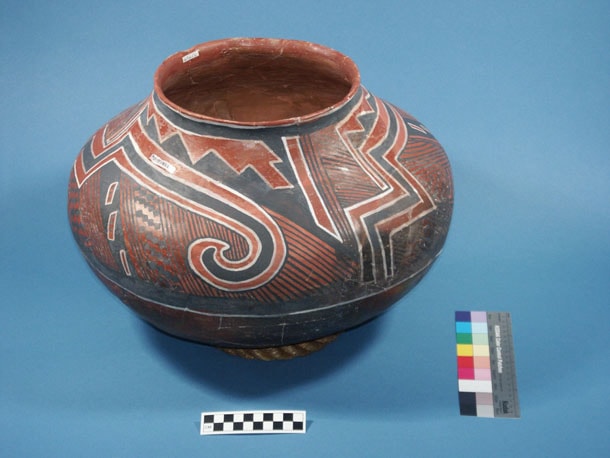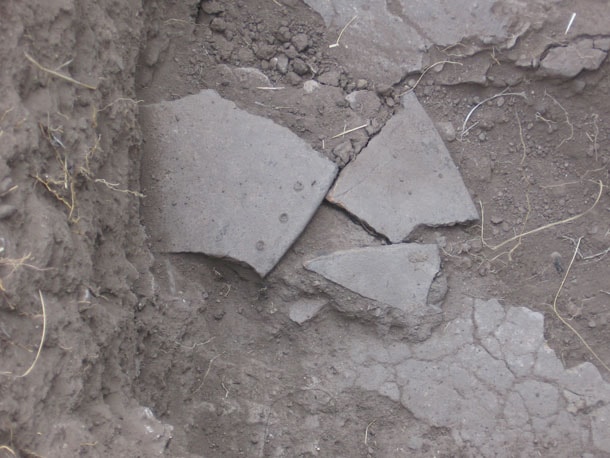- Home
- >
- Preservation Archaeology Blog
- >
- Learning from Pottery, Part 2: Migration and Trade
 |
By Deborah L. Huntley, Preservation Archaeologist
|
A few weeks ago, I wrote about how decorated pottery is helping us determine when the various large sites we have investigated in the Mule Creek area were occupied (see Learning from Pottery, Part 1: Dating). We can also use pottery to understand phenomena such as long-distance trade and migration. As I mentioned in my previous blog, 3-Up, Gamalstad, and Fornholt have some interesting differences in terms of their pottery assemblages, despite their close proximity to one another in the Mule Creek Valley. Gamalstad is so unique that it deserves its own blog. Here, I’ll focus on the strong contrasts between 3-Up and Fornholt, which suggest that groups of people with different cultural affiliations lived at these neighboring sites in the late 13th and early 14th centuries A.D.
One of the main contrasts between 3-Up and Fornholt is in their proportions of different ceramic wares. A ware is a ceramic tradition—usually associated with a particular geographic area and time period—that is made up of several types. Ceramic wares are often distinguished on the basis of how they were made, including the types of clays and slips used, material used for temper, overall color scheme, and design layout. Archaeologists tend to assume that people who had similar cultural backgrounds made and used the same suite of wares. Conversely, people from different cultural backgrounds may have made and used different wares.

In our excavations at one area of the 3-Up site, Locus B, we found relatively large proportions of Maverick Mountain series ceramics. These vessels, which mimic pottery made in the Kayenta/Tusayan area far to the north, are quite distinctive. Compositional data (Neutron Activation Analysis for clay composition plus temper identifications) indicate many of them were made using clays and volcanic sands available near 3-Up or elsewhere in the surrounding Upper Gila region. We think the Maverick Mountain series pottery was made by immigrants living at 3-Up who used local materials to replicate Kayenta pottery they had learned to make in northern Arizona. Supporting evidence for Kayenta immigrants at 3-Up comes from another part of the site, Locus C, where we found a broken perforated plate. This item is a pottery-making tool that appears to be unique to the Kayenta tradition.
Much to our surprise, not a single Maverick Mountain series sherd has yet been recovered in our three seasons of work at Fornholt. Instead, we have found Cibola White Ware and White Mountain Red Ware sherds that ceramic cross-dating tells us were made and used during the mid-1200s through early 1300s (see Learning from Pottery, Part 1: Dating). These vessels were not made in the Upper Gila region; they have light-colored clay fabrics and crushed sherd temper that is typical of the Cibola area on the Colorado Plateau north of Mule Creek. As such, these vessels must have been brought to Fornholt. The 3-Up site has some of these types, as well.
It seems to us that 3-Up and Fornholt had very different social connections during the mid-1200s to early 1300s. In fact, Fornholt’s connections seem to have been somewhat restricted, whereas 3-Up was probably more culturally diverse and connected to many different areas. At 3-Up, immigrants from the Tusayan/Kayenta area settled a portion of the site in the 1200s, probably co-existing side by side with people who had a longer history in the Mule Creek area. We think that the immigrants kept their ties with other immigrant enclaves in the southern Southwest, trading pottery and obsidian within a large regional network. There is not much evidence that Fornholt’s residents participated in this network, at least as far as pottery goes. And this is not the only difference between the two sites: they appear quite different in overall layout, architectural features, and construction materials, as well.

It is tempting to speculate about the relationship between 3-Up and Fornholt during the 1200s. Were groups at these two villages competing with one another? We don’t have the answer yet, but whatever the social climate was in Mule Creek during the 1200s, Fornholt appears to have been abandoned by the early 1300s. 3-Up, however, had a large population well into the late 1300s. This time was the height of the Salado phenomenon in the southern Southwest (see Jeff Clark’s Nov. 8 blog on Inclusion and Exclusion), and 3-Up appears to have been the center of this phenomenon in the Mule Creek Valley. But that is another story…
Explore the News
-
Join Today
Keep up with the latest discoveries in southwestern archaeology. Join today, and receive Archaeology Southwest Magazine, among other member benefits.